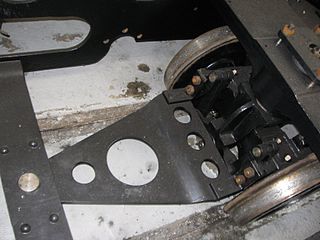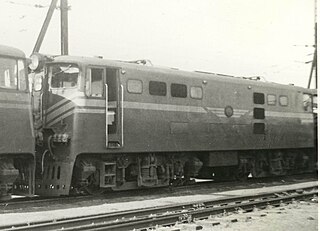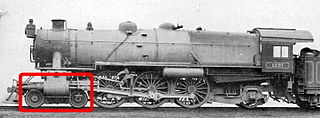
A bogie is a chassis or framework that carries a wheelset, attached to a vehicle—a modular subassembly of wheels and axles. Bogies take various forms in various modes of transport. A bogie may remain normally attached or be quickly detachable ; it may contain a suspension within it, or be solid and in turn be suspended ; it may be mounted on a swivel, as traditionally on a railway carriage or locomotive, additionally jointed and sprung, or held in place by other means.

A tank locomotive or tank engine is a steam locomotive that carries its water in one or more on-board water tanks, instead of a more traditional tender. Most tank engines also have bunkers to hold fuel; in a tender-tank locomotive a tender holds some or all of the fuel, and may hold some water also.

The Lancashire and Yorkshire Railway Class 5 were 2-4-2T steam locomotives designed by Chief Mechanical Engineer (CME) John Aspinall and introduced from 1889 for local passenger work. Later batches included progressive modifications such as extended coal bunkers and belpaire fireboxes. The final batch built from 1911 to 1914 under George Hughes incorporating superheated boilers and belpaire firebox gave increased tractive effort, others were also rebuilt to this standard. When Hughes introduced his classification system in 1919 the more powerful superheated locomotives were designated Class 6. The final examples were withdrawn in 1961.

South Australian Railways (SAR) was the statutory corporation through which the Government of South Australia built and operated railways in South Australia from 1854 until March 1978, when its non-urban railways were incorporated into Australian National, and its Adelaide urban lines were transferred to the State Transport Authority.

William Adams was an English railway engineer. He was the Locomotive Superintendent of the North London Railway from 1858 to 1873; the Great Eastern Railway from 1873 until 1878 and the London and South Western Railway from then until his retirement in 1895. He is best known for his locomotives featuring the Adams bogie, a device with lateral centring springs to improve high-speed stability. He should not be mistaken for William Bridges Adams (1797–1872) a locomotive engineer who, confusingly, invented the Adams axle – a radial axle that William Adams incorporated in designs for the London and South Western Railway.
William Bridges Adams was an English author, inventor and locomotive engineer. He is best known for his patented Adams axle – a successful radial axle design in use on railways in Britain until the end of steam traction in 1968 – and the railway fishplate. His writings, including English Pleasure Carriages (1837) and Roads and Rails (1862) covered all forms of land transport. Later he became a noted writer on political reform, under the pen name Junius Redivivus ; a reference to a political letter writer of the previous century.
A lateral motion device is a mechanism used in some railroad locomotives which permits the axles to move sideways relative to the frame. The device facilitates cornering.
The Lyme Regis branch line was a railway branch line connecting the seaside town of Lyme Regis with the main line railway network at Axminster, running through picturesque rural countryside on the Dorset - Devon border.
The Bristol and Exeter Railway Fairfield was an experimental broad gauge self-propelled steam carriage. In later use the carriage portion was removed and it was used as a small shunting locomotive.

The LSWR 415 class is a steam tank locomotive of 4-4-2T wheel arrangement, with the trailing wheels forming the basis of its "Radial Tank" moniker. It was designed by William Adams and introduced in 1882 for service on the London and South Western Railway (LSWR).

A Bissell or Bissel truck is a single-axle bogie which pivots towards the centre of a steam locomotive to enable it to negotiate curves more easily. Invented in 1857 by Levi Bissell and usually then known as a pony truck, it is a very simple and common means of designing a carrying wheel.

The 26 class was a class of steam locomotives built by Dübs and Company for the New South Wales Government Railways of Australia.

The Adams axle is a form of radial axle for rail locomotives that enable them to negotiate curves more easily. It was invented by William Bridges Adams and patented in 1865. The invention uses axle boxes that slide on an arc in shaped horn blocks, so allowing the axle to slide out to either side. This is similar to the movement of a Bissell truck, but with the notional centre point of the curve being where the pivot of the truck would be. This design, using slide bearings, is more expensive than one employing a shaft, but takes up less space.

The South African Railways Class 5E1, Series 1 of 1959 was an electric locomotive.

The South African Railways Class 5E1, Series 2 of 1963 was an electric locomotive.

The South African Railways Class 5E1, Series 3 of 1964 was an electric locomotive.

The leading wheel or leading axle or pilot wheel of a steam locomotive is an unpowered wheel or axle located in front of the driving wheels. The axle or axles of the leading wheels are normally located on a leading truck. Leading wheels are used to help the locomotive negotiate curves and to support the front portion of the boiler.

The South African Railways Class GO 4-8-2+2-8-4 of 1954 was an articulated steam locomotive.

The Natal Government Railways 4-6-2TT Havelock of 1888 was a South African steam locomotive from the pre-Union era in the Natal Colony.
A cannon bearing or cannon box bearing is an arrangement of bearings on a shaft, usually an axle, where two bearings are mounted in an enclosed tube.